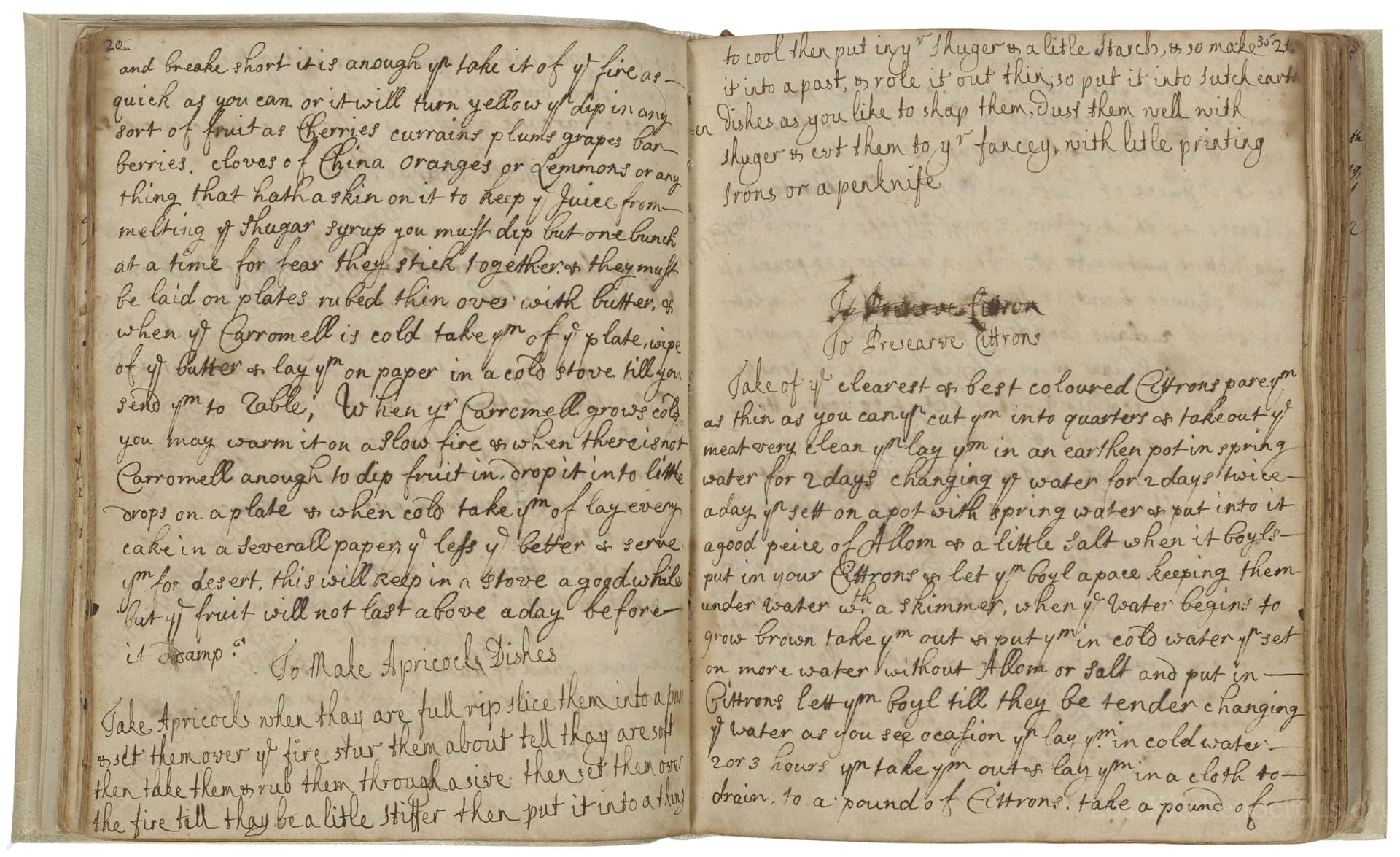To Make Apricock Dishes
From the treasured pages of Cook-book of Margaret Turner
Written by Margaret Eyre

To Make Apricock Dishes
"Take Apricocks when thay are full ripe slice them into a pan sett them over ye fire stur them about tell they are soft then take them out rub them through a sive then set them over the fire till they be a litle stiffer then put it into a thing to cool then put in yr Shuger & a litle starch, & so make it into a past, & role it out thin in Dishes as you like to shap them, dust them well with shuger & cut them to yr fancy, with litle printing Irons or a penknife"
Note on the Original Text
Written in the style typical of early modern English manuscripts, this recipe employs phonetic spelling (e.g., 'Apricocks' for apricots), period abbreviations ('yr' for 'your'), and minimal punctuation. Instructions are brief and assume a working knowledge of kitchen technique—a common expectation for domestic manuscript readers of the time. Technical terms like 'rub them through a sive' simply mean to purée, and 'set them over ye fire' refers to stovetop cooking. The vagueness about quantities, temperatures, and times reflects a period before standardized measurements, relying strongly on the cook’s experience and intuition.

Title
Cook-book of Margaret Turner (1709)
You can also click the book image above to peruse the original tome
Writer
Margaret Eyre
Era
1709
Publisher
Unknown
Background
Step into the refined world of early 18th-century cookery with Margaret Eyre, where recipes are whispered secrets and culinary wonders await. From hearty roasts to delicate sweets, this charming tome serves up inspiration fit for the tables of historic England.
Kindly made available by
Folger Shakespeare Library
This delightful recipe originates from Margaret Eyre, born around 1686, and is dated to approximately 1709. In early 18th-century England, such fruit pastilles or 'dishes' were popular as elegant table sweets or banqueting treats. Serving fruits in this refined, decorative manner showed culinary skill and status, especially during times when sugar was an expensive ingredient. Apricots, having been introduced to England some decades prior, became a favorite in aristocratic gardens and kitchens alike. These dishes were often presented as part of the last, most lavish course of a meal—the 'banquet'—where elaborate sweetmeats, candied fruits, and decorative confections dazzled guests.

In the early 1700s, cooks would have used a heavy iron or brass pan set over a hearth fire to gently soften the apricots. After cooking, a fine-mesh sieve (often made of hair or cloth) would be used to purée the fruit. The paste might be cooled in shallow wooden dishes, then rolled out on a large, floured board. To shape the pastes, small penknives or metal 'printing irons' (early cutters) enabled the cook to create floral or fanciful shapes. Generous shaking of sugar—sometimes through a muslin bag—ensured a sweet, non-stick finish.
Prep Time
10 mins
Cook Time
15 mins
Servings
10
We've done our best to adapt this historical recipe for modern kitchens, but some details may still need refinement. We warmly welcome feedback from fellow cooks and culinary historians — your insights support the entire community!
Ingredients
- 18 oz ripe apricots (fresh)
- 2.6 oz granulated sugar
- 0.14 oz cornstarch (as substitute for historical starch)
Instructions
- Begin by selecting ripe apricots, about 18 ounces, and slice them into a saucepan.
- Set the pan over medium heat and stir gently until the fruit softens and begins to break down (about 10-12 minutes).
- Once soft, remove the apricots from the heat and pass them through a fine sieve to create a smooth purée.
- Return the purée to the pan and cook gently for a few more minutes until it thickens slightly—think the consistency of a soft paste.
- Allow this to cool briefly, then add 2.6 ounces of sugar and a teaspoon (about 0.14 ounces) of cornstarch (as a modern substitute for starch), mixing to create a pliable paste.
- Roll out this apricot paste thinly between two sheets of parchment on a tray.
- Dust generously with sugar to prevent sticking and, using cookie cutters or a sharp knife, cut into decorative shapes as desired.
- Let these set at room temperature before serving.
Estimated Calories
70 per serving
Cooking Estimates
Preparing the apricots and mixing the paste takes about 10 minutes. Cooking and thickening the purée takes another 15 minutes. Each serving is estimated to have around 70 calories, and this recipe makes 10 small pieces.
As noted above, we have made our best effort to translate and adapt this historical recipe for modern kitchens, taking into account ingredients nowadays, cooking techniques, measurements, and so on. However, historical recipes often contain assumptions that require interpretation.
We'd love for anyone to help improve these adaptations. Community contributions are highly welcome. If you have suggestions, corrections, or cooking tips based on your experience with this recipe, please share them below.
Join the Discussion
Rate This Recipe
Dietary Preference
Main Ingredients

Den Bockfisch In Einer Fleisch Suppen Zu Kochen
This recipe hails from a German manuscript cookbook compiled in 1696, a time whe...

Die Grieß Nudlen Zumachen
This recipe comes from a rather mysterious manuscript cookbook, penned anonymous...

Ein Boudain
This recipe comes from an anonymous German-language manuscript cookbook from 169...

Ein Gesaltzen Citroni
This recipe, dating from 1696, comes from an extensive anonymous German cookbook...
Browse our complete collection of time-honored recipes



